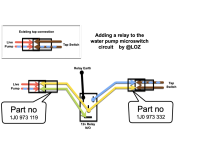L
Legin
Guest User
I fitted a shower to my T6 the same one as factory and whilst I was at it fitted a relay to protect the tap microswitch.
From what I have read the tap fails due to the contacts failing so hopefully this will mean I dont suffer the same fate now the relay takes the load.
I fitted it into the the tap flying leads at the tap and once you take the drawer out isnt that difficult.
From what I have read the tap fails due to the contacts failing so hopefully this will mean I dont suffer the same fate now the relay takes the load.
I fitted it into the the tap flying leads at the tap and once you take the drawer out isnt that difficult.















